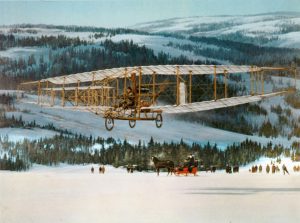
It’s one of those iconic Canadian images – when you’re a Canadian kid growing up with history books and images of Canadiana all around – that registers permanently.
It shows a biplane – really little more than a pair of kite-type wings with a man, Douglas McCurdy, sitting on the lower wing at the controls – flying over a wintry scene. It’s the Silver Dart, flying just a few feet above the frozen surface of Bras d’Or Lake near Baddeck, Nova Scotia, on Feb. 23, 1909. And as iconic as the image is, I only learned this week who captured it.
“I’m Kathryn Bradford Stevens,” said the speaker at the function I attended this week. “I’m the daughter of aviation artist Robert Bradford.”
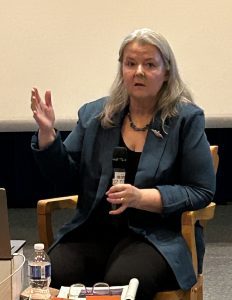
Kathryn’s father died in May 25, 2023, in his 100th year. And to help celebrate his extraordinary life in aviation and preserving aviation history, she agreed to speak to the Toronto chapter of the Canadian Aviation Historical Society last weekend. We’d gathered to hear her in a lecture hall at Canadian Forces College in Toronto.
“What Dad has depicted here is the first flight of the Silver Dart,” Kathryn began.
And, as I said, it’s indelible, those few moments of flight over about half a mile of frozen lake. But what she then noted are all the things in that historical image that we mostly overlook. It was damn cold that day!
“You can feel the cold,” she continued. “You can see the breath coming from the horse drawing the red sleigh in the background.”
I’ve never noticed the sleigh before, the sleigh just below the aircraft. And, yes, there’s steam coming off the horse and from the people seated in the sleigh. And did you know who’s there in the sleigh, by the way?
“That’s Alexander Graham Bell and his wife,” Kathryn pointed out. Bell was not only known for his pioneer work with telephone communications, but also with something called the Aerial Experiment Association (AEA), formed under Bell’s guidance. But “Mrs. Bell (Mabel Gardiner Hubbard Bell) is a very famous woman in aviation history; she bankrolled the development of many of the AEA pioneer aircraft,” Kathryn went on.
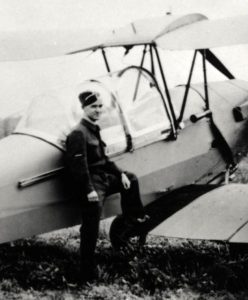
And there’s more. If you’ve ever visited Baddeck Bay on Cape Breton, you’ll know that the inland countryside there has very little contour. And so, the artist’s daughter speculates, “I think Dad might have exaggerated the hills a bit, taking artistic licence.”
Robert Bradford was born in Toronto in 1923 and, like lots of boys growing up in the 1930s, fell in love with aviation and the notion of flying. In 1941, at age 18, he enlisted in the RCAF, trained here in Canada, and in 1944 went overseas to serve in the Royal Air Force as a staff pilot.
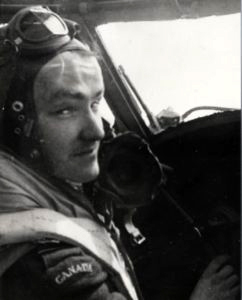
From my own research, these pilots were worth their weight in gold, helping wartime pilots, navigators, and wireless radio operators learn the skills required to crew bomber and fighter aircraft to defeat Hitler’s Luftwaffe.
Post war, Bradford illustrated for A.V. Roe (who designed/built Lancasters and the Arrow), then moved to de Havilland. As his daughter pointed out, while he had a day job and family to attend to, he always made time for his passion.
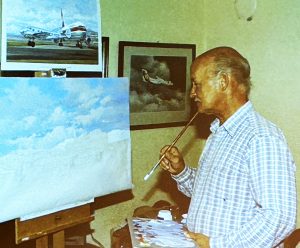
“These paintings were painted in the basement of our Don Mills home, with artificial light, many hundreds of hours of research and sketching and painting,” she said.
In 1961, Robert Bradford created four aviation paintings for a calendar. His ability to capture aircraft suspended in mid-flight as well as the atmosphere of the space surrounding them was uncanny.
What’s more, designers and manufacturers relied on the details of the aircraft he painted to generate blueprints, schematics and actual replicas of the aircraft themselves.
The National Aviation Museum, whose collection Bradford would later curate, next commissioned him to capture many of these historic Canadian aviation moments, including McCurdy’s flight in the Silver Dart, for its collection.
Then, in the 1980s Canada Post invited him to capture even more with classic images of float planes, bombers, trainers, jets and bush planes on 16 postage stamps. He continued to paint into his centennial year. For his daughter, however, the Silver Dart painting holds particular significance.
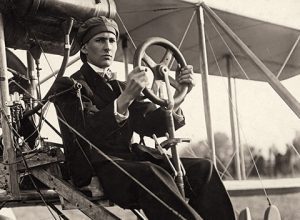
“I went through private pilot training myself,” she explained. “And after I flew solo, my dad gifted me a copy of (the Silver Dart) painting, signed. And on it he wrote, ‘Now you know how McCurdy felt.’”
“Very true,” she admitted, “because, yes, McCurdy was probably a little anxious. And I was a little anxious.”
Only an artist who understood his subject by experience the way Robert Bradford did could capture that in a paintbrush stroke.
The article about Arthur Crighton was very touching , he was my uncle and our hero !!!